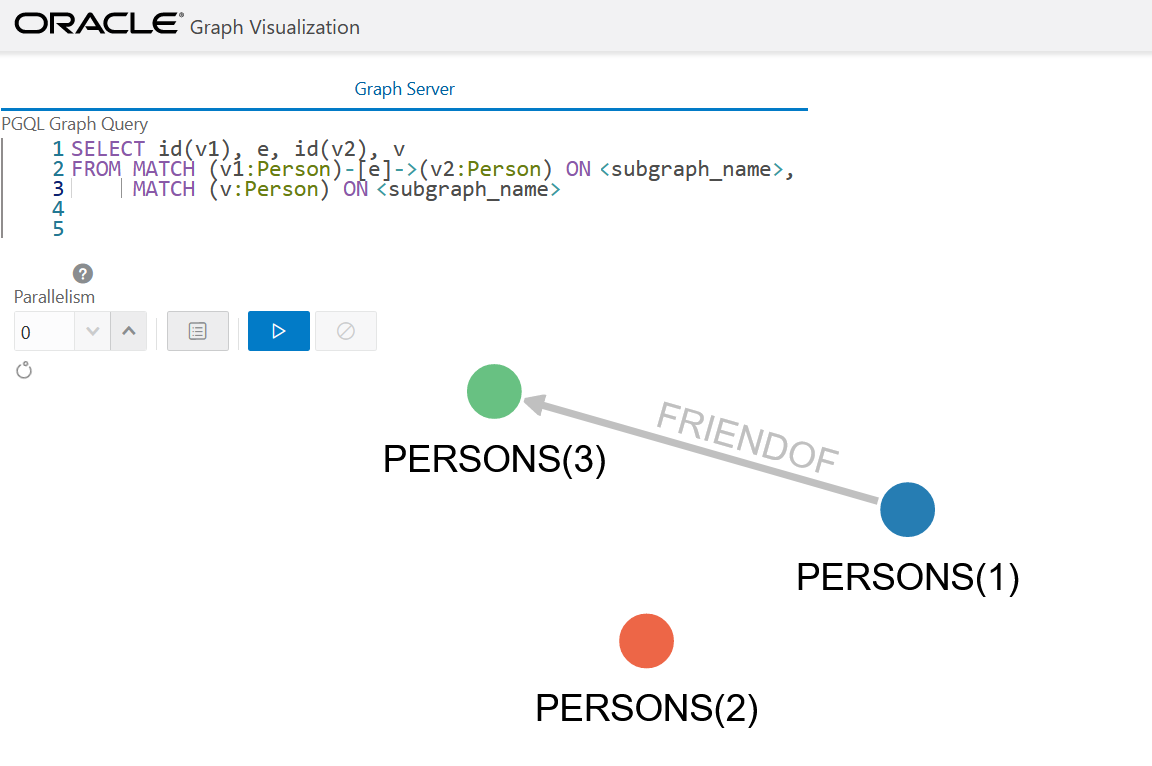10.4.1 PGQL Based Subgraph Loading
You can use the PgViewSubgraphReader#fromPgView API to
create an in-memory subgraph from a PGQL property graph using a set of PGQL queries.
These PGQL queries define the vertices and edges that are to be loaded into the subgraph. You can also use multiple PGQL queries and the resulting output graph is a union of the subgraphs, each being loaded independently by each PGQL query.
Note:
- Only non-composite vertex and edge keys are supported.
- Only numeric edge keys are supported.
- PGQL queries with
GROUP BYorORDER BYclauses are not supported for loading of subgraphs from a PGQL property graph.
The following example creates a subgraph from a PGQL property graph using multiple PGQL queries:
opg4j> var graph = session.readSubgraph().
...> fromPgView("FRIENDS").
...> queryPgql("MATCH (v1:Person)-[e:FRIENDOF]->(v2:Person) WHERE id(v1) = 'PERSONS(1)'").
...> queryPgql("MATCH (v:Person) WHERE id(v) = 'PERSONS(2)'").
...> load()
graph ==> PgxGraph[name=FRIENDS,N=3,E=1,created=1646726883194]PgxGraph graph = session.readSubgraph()
.fromPgView("FRIENDS")
.queryPgql("MATCH (v1:Person)-[e:FRIENDOF]->(v2:Person) WHERE id(v1) = 'PERSONS(1)'")
.queryPgql("MATCH (v:Person) WHERE id(v) = 'PERSONS(2)'")
.load();>>> graph = session.read_subgraph_from_pg_view("FRIENDS", ["MATCH (v1:Person)-[e:FRIENDOF]->(v2:Person) WHERE id(v1) = 'PERSONS(1)'",
... "MATCH (v:Person) WHERE id(v) = 'PERSONS(2)'"])
>>> graph
PgxGraph(name: FRIENDS, v: 3, e: 1, directed: True, memory(Mb): 0)The following displays the output for the preceding PGQL query using the graph visualization tool.
Loading Subgraphs with Custom Names
By default, the new subgraph gets created with the same name as the PGQL property graph. Alternatively, if you want to load a subgraph with a custom name, then you can configure the subgraph name as shown:
opg4j> var graph = session.readSubgraph().
...> fromPgView("FRIENDS").
...> queryPgql("MATCH (v1:Person)-[e:FRIENDOF]->(v2:Person) WHERE id(v1) = 'PERSONS(1)'").
...> queryPgql("MATCH (v:Person) WHERE id(v) = 'PERSONS(2)'").
...> load("friends_network")
graph ==> PgxGraph[name=friends_network,N=3,E=1,created=1664458398090]PgxGraph graph = session.readSubgraph()
.fromPgView("FRIENDS")
.queryPgql("MATCH (v1:Person)-[e:FRIENDOF]->(v2:Person) WHERE id(v1) = 'PERSONS(1)'")
.queryPgql("MATCH (v:Person) WHERE id(v) = 'PERSONS(2)'")
.load("friends_network");>>> graph = session.read_subgraph_from_pg_view("FRIENDS",
... ["MATCH (v1:Person)-[e:FRIENDOF]->(v2:Person) WHERE id(v1) = 'PERSONS(1)'",
... "MATCH (v:Person) WHERE id(v) = 'PERSONS(2)'"],
... graph_name="friends_network")
>>> graph
PgxGraph(name: friends_network, v: 3, e: 1, directed: True, memory(Mb): 0)Loading a Subgraph by Explicitly Specifying the Schema Name
If you want to load a subgraph by reading a PGQL property graph from
another schema, you can additionally provide the schema name as an
argument to the PgViewSubgraphReader#fromPgView API
. You must also ensure that you have READ
permission on all the underlying metadata and data tables for the
PGQL property graph.
For example:
opg4j> var graph = session.readSubgraph()
...> .fromPgView("GRAPHUSER", "FRIENDS")
...> .queryPgql("MATCH (v:Person) WHERE id(v) = 'PERSONS(2)'")
...> .load()
graph ==> PgxGraph[name=FRIENDS,N=1,E=0,created=1672743755511]PgxGraph graph = session.readSubgraph()
.fromPgView("GRAPHUSER", "FRIENDS")
.queryPgql("MATCH (v:Person) WHERE id(v) = 'PERSONS(2)'")
.load();>>> graph = session.read_subgraph_from_pg_view("FRIENDS",
... ["MATCH (v:Person) WHERE id(v) = 'PERSONS(2)'"],
... schema="GRAPHUSER")Parent topic: Loading a Subgraph from a PGQL Property Graph
